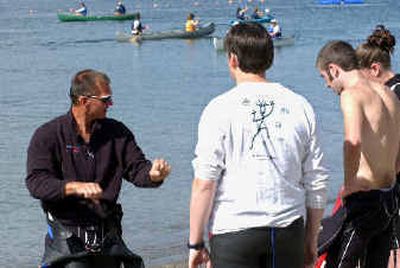Wolf packs to prowl in Ironman race

Wolf packs will be on the hunt during the 2.4-mile swim that kicks off Ironman this year.
Twenty-six teams of divers, kayakers and canoeists, deemed “wolf packs” by organizers, will creep up on stragglers, surround swim victims and swoop their catch away from the herd of about 2,000 swimmers.
Pee Wee Bramblett, Ironman swim course coordinator, trained eight new teams over the weekend near Independence Point. Volunteers whistled, waved paddles in the air, and pointed at a pretend victim. Each practiced maneuvers to paddle with the flow of invisible swimmers and block a path for rescue divers.
“It’s pretty intense,” said Chip Dalvini, who co-captains the kayak and canoe team with his wife, Ginger. “If you’ve got to go into 2,000 swimmers, you’ve got to know how to maneuver.”
When finished with the swim, competitors will strip off their wetsuits, bike 112 miles and run 26.2 miles before crossing the finish line by midnight Sunday.
Course changes this year will add challenges to divers, but rescue teams will hardly notice, said Bramblett, who’s from Clermont, Fla. Last year, the first leg of the swim was about 300 yards. That will more than double to about 700 yards this year. The length will allow swimmers to spread out more and avoid “beating each other to get around” the first corner, he said.
The new challenge for volunteers will be working in deeper water, which means rescue boats will need to be anchored from about 100 feet above, and divers will have less dive time. Divers are stationed on rescue boats until needed for rescue.
Rescuers typically pick up six to nine swimmers and the goal is to get to them within 30 seconds. The wolf pack rescue plan was first used in last year’s Ironman and worked well to meet the rescue goals. Event organizers decided to use it again this year.
“We don’t know what their backgrounds are or where they come from,” said Bramblett of the rescuers. “But our objective is to, in a couple of hours, be able to work as a team.”
The teams meander in zones along the course and work with 13 lifeguards, six spotters, six jet skis and 10 boats. Volunteers come from the Coast Guard reserve, private diving groups and the Kootenai County Sheriff’s Department.
Deputy Ken Lallatin is one of nine active members of the sheriff’s department dive team, which will help at the event.
He helped out last year and spotted a woman struggling, but she wanted to keep trying. Eventually, she couldn’t stay afloat and he grabbed her.
“At that point, she was more scared,” he said. “It was obvious she was in a dangerous situation.”
Lallatin said teamwork is crucial to a safe rescue and it helps to know teammates beforehand. His team trains year-round in water rescue and recently started using jet skis. Lallatin hopes to have four jet skis on the lake during the event.
Dalvini said volunteering on the swim course again this year has been rewarding because it brings kayakers together.
“We’re independent by nature,” he said. “And here we were able to put out 15-some-odd boats together and learn rescue skills.”